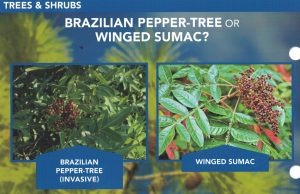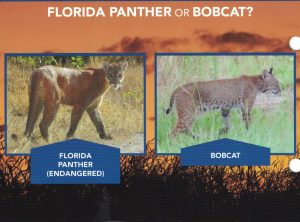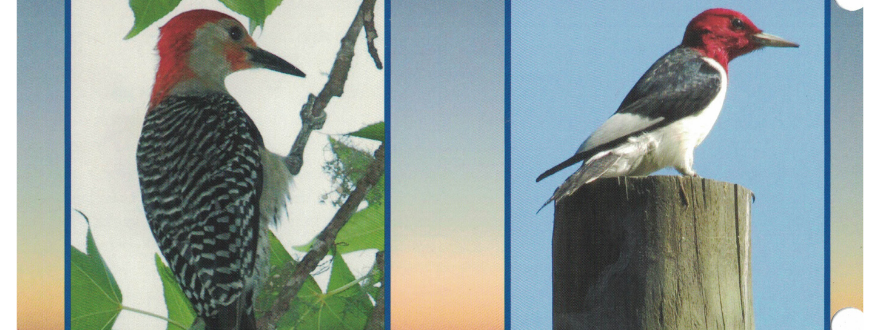[printfriendly]
[su_pullquote align= ‘right’] Side by side comparison of red-bellied woodpecker and a red-headed woodpecker.[/su_pullquote]How can you tell a red-bellied woodpecker from a red-headed woodpecker when both species have red heads and the red belly is only slightly tinted?
In large part, by where you see them. Red-bellied woodpeckers are commonly seen in urban areas with mature trees. Red-headed woodpeckers are much rarer, particularly in urban areas.
 If you’re like me and are naturally curious about what you’re seeing outdoors, “This or That? A Beginner’s Guide to Commonly Misidentified Plants & Animals in Florida” is the book you need. Printed on laminated card stock to weather the outdoors, it was written by two Pinellas County extension agents and published by the University of Florida.
If you’re like me and are naturally curious about what you’re seeing outdoors, “This or That? A Beginner’s Guide to Commonly Misidentified Plants & Animals in Florida” is the book you need. Printed on laminated card stock to weather the outdoors, it was written by two Pinellas County extension agents and published by the University of Florida.
 “This or That?” is not your typical guidebook, though. Along with detailed descriptions of everything from bobcats to water snakes, it also compares and contrasts the descriptions with similar species. Bobcats, for instance, are much smaller than the endangered Florida panther and have shorter tails. Water snakes have rounded heads with no distinct “neck,” while the venomous water moccasin has a blocky head and a dark brown stripe from its eyes to the corners of its mouth.
“This or That?” is not your typical guidebook, though. Along with detailed descriptions of everything from bobcats to water snakes, it also compares and contrasts the descriptions with similar species. Bobcats, for instance, are much smaller than the endangered Florida panther and have shorter tails. Water snakes have rounded heads with no distinct “neck,” while the venomous water moccasin has a blocky head and a dark brown stripe from its eyes to the corners of its mouth.
The idea for an ID book came from working with volunteers in local parks and nature preserves, said James Stevenson, one of the handbook’s authors. “Volunteers were trying to help visitors identify certain species, and they came to us when they were having trouble telling easily confused species apart,” Stevenson said.
 “Once you know what to look for, it makes it much easier to tell the species apart,” adds Lara Milligan, another of the authors. In addition to satisfying a natural curiosity about the world around us, the book will help users identify invasive and endangered species, as well as venomous ones, Milligan said.
“Once you know what to look for, it makes it much easier to tell the species apart,” adds Lara Milligan, another of the authors. In addition to satisfying a natural curiosity about the world around us, the book will help users identify invasive and endangered species, as well as venomous ones, Milligan said.
“The first step in dealing with an invasive species is being able to identify it, so this is a tool people can use to determine if they are seeing something that’s a problem,” Milligan said. “The same is true for threatened and endangered species, such as the American crocodile or Florida panther—when people report sightings, that helps wildlife managers conserve those species.”
 The same principle applies to venomous snakes. “Some people might think that any snake you see near water is a water moccasin, but it could be a southern water snake, which isn’t venomous,” Stevenson said. “Of course, you never want to intentionally disturb a snake or any other wildlife, so it’s always best to observe at a safe distance—if you don’t bother them, they won’t bother you.”
The same principle applies to venomous snakes. “Some people might think that any snake you see near water is a water moccasin, but it could be a southern water snake, which isn’t venomous,” Stevenson said. “Of course, you never want to intentionally disturb a snake or any other wildlife, so it’s always best to observe at a safe distance—if you don’t bother them, they won’t bother you.”
Although it’s billed as a “beginner’s guide,” its focus on highlighting the difference between similar species makes it a great resource even for people who have lived in Florida their entire lives.
For instance:
- The invasive Chinese privet has small flowers with four petals while the native possumhaw has larger flowers with five petals.
- The old saying about “red touches yellow, kill the fellow” has a ring of truth when describing a venomous eastern coral snake. Of course, you don’t want to kill a shy snake, even if it is venomous, but “red touches black, OK Jack” perfectly describes the scarlet kingsnake.
- Invasive — and toxic — cane toads are much larger – up to nine inches across – than the commonly confused southern toad that also has ridges on the top of its head.
-
 The non-native apple island snail is nearly twice as large as the native Florida apple snail. You’re also likely to see the island snail’s distinctive bright pink egg masses before you see the snail itself.
The non-native apple island snail is nearly twice as large as the native Florida apple snail. You’re also likely to see the island snail’s distinctive bright pink egg masses before you see the snail itself. - The invasive taro plant differs from the native green arum in that the taro leaf tips point down and the arum points up.
You can buy the book online at www.ifasbooks.com or call 352-392-1764. Several people I love will find copies underneath their Christmas tree this year but if you don’t need a hard copy of the handbook, check out the Pinellas Extension’s website for similar information online.
[su_divider]
